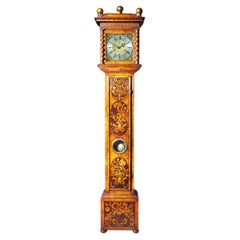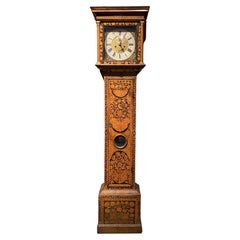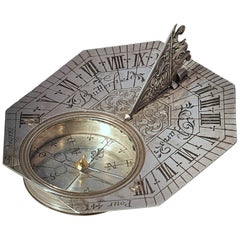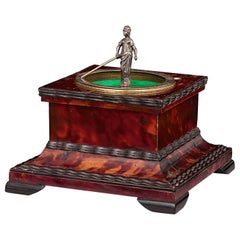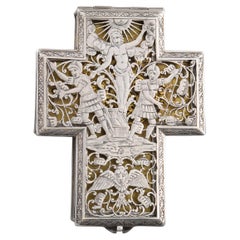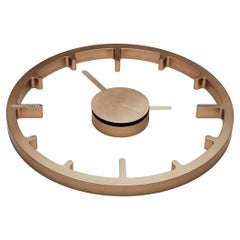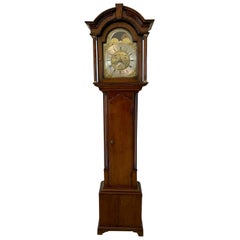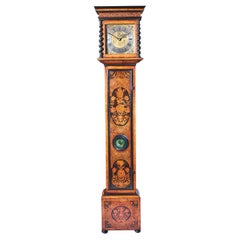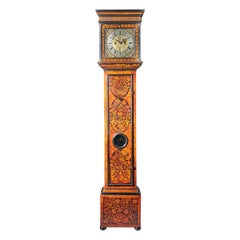17th Century More Clocks
to
5
50
202
85
82
23
35
15
5
1
4
2
1
3
4
6
3
1
5
3
3
2
2
3
2
5
2
1
1
1
Height
to
Width
to
5
5
5
1
Period: 17th Century
17th Century Charles II Month Going Marquetry Longcase Clock by John Wise
Located in Oxfordshire, United Kingdom
A superb Charles II month duration floral marquetry longcase clock by the well-known maker John Wise, c. 1680-85. Measure: 10".
The case is of the highest quality and decorated throughout in very attractive floral marquetry depicting spring flowers and birds showing a high level of sophistication with a glazed circular lenticle to the door. Similarly, the rising hood is decorated with blind frets around the top and surmounted by a shallow caddy decorated by five gilt wooden ball finials. It is flanked by prominent gilt brass-capped solid barley twist columns, with blind fretted panels to the sides.
The month-going nicely finned and knopped five pillar movement has reversed going and striking trains, the striking train (on the right) being regulated by a small outside countwheel. The going train has anchor escapement and a seconds pendulum. The movement is fronted by a 10-inch brass dial with an unusual narrow silvered chapter ring, seconds ring and date aperture. It has elaborate cherub-head spandrels in the corners and is signed along the bottom John Wise Londini Fecit. The middle is finely matted, whilst the time is indicated by a fine pair of blued-steel hands, the hour hand richly pierced.
The maker
John Wise was born in Banbury shortly before 17 March 1624, the date of his baptism. He was the son of John and Ann Wise and a cousin of Joseph Knibb...
Category
British Charles II Antique 17th Century More Clocks
Materials
Brass, Steel
William & Mary Floral Marquetry 8-Day Longcase Clock by LeCount 'LeCompte'
Located in Milford, NH
A fine and rare William & Mary long case or grandfather clock by London maker Daniel LeCompte. c.1690, London, the fine marquetry case having oval panels of birds and flowers, the movement signed Daniel LeCount (LeCompte) having a silver chapter ring and seconds dial, brass spandrels of cupids supporting a crown; including key, weights and pendulum. LeCompte was a French Huguenot...
Category
English Antique 17th Century More Clocks
Materials
Brass
Rare Silver Pocket Sundial and Compass by Michael Butterfield, Paris, circa 1700
Located in Oxfordshire, United Kingdom
A beautiful, rare solid silver Anglo-French octagonal pocket sundial with compass by Michael Butterfield, circa 1700.
The sundial is made for a latitude of 44° and could be used in places in the south of France such as Avignon and elsewhere along this parallel. The elaborately engraved base plate has a Roman chapter ring on which the gnomon (a triangular flap) casts its shadow. It is signed by the maker in the following manner: Butterfield A Paris. On one side is a glazed recessed compass with a blued steel hand to position the instrument in such a way that the time can be read. The hinged triangular gnomon is richly engraved and in the shape of a bird’s head. The folding gnomon and cut corners enable the dial to be carried in the pocket.
The underside shows the latitudes of various Southern-French places in the relevant areas
Its maker Michael Butterfield was an English instrument maker who based himself in 'Le Quay de l'Horloge' of Paris from circa 1685. These types of dials, often replicated by other makers, became known as Butterfield Dials...
Category
French Louis XIV Antique 17th Century More Clocks
Materials
Silver
Buschman “Minerva” German Horizontal Table Clock
Located in New Orleans, LA
The extraordinary beauty and superior craftsmanship of 17th century German clockmaking is on full display in this exceptionally rare horizontal tabletop timepiece dating to 1650 Augsburg. Created by Johannes Buschman the Younger, the eminent Buschman family of clockmakers are lauded for designing some of the finest timepieces to ever be created in the South German town of Augsburg during the late Renaissance and early Modern periods. A finely moulded ebony and turtleshell casing veneered in a mottled red hue holds the clock’s fusée and chain movement with verge escapement and balance with hogs-bristle regulation. A silver figure of Minerva, Roman goddess of war and wisdom, centers the Roman numeral-engraved chapter ring, indicating the time by pointing to the hour with an authoritative military staff as the sun rotates below her feet to indicate the minute. The incredible design is finished by a gilded backplate intricately pierced and engraved with a floral motif and the signature of Johannes Buschman.
Clocks are one of the greatest and most important inventions of the Renaissance period, improving steadily into the Age of Discovery. Embodying a renewed interest in science, the arts and humanism, the first mechanical timepieces began appearing in the 14th century and were large, weight-driven devices placed in the turrets of public buildings that struck the hour and lacked hands and faces. This clock was created during the first period of household clocks, when spring-driven movements made it possible to create smaller and more complex mechanisms. Such creations, however, were a luxury accessible only to the wealthy upper classes. Affluent patrons placed pressure upon artisans to create more elaborate and ornate clocks...
Category
German Renaissance Antique 17th Century More Clocks
Materials
Silver
Cross-Shaped Chest Clock, Silver, 17th Century, it Presents Restorations
Located in Madrid, ES
Cross-shaped chest clock. Silver. 17th century. It presents restorations.
Portable clock in the shape of a cross with an openwork exterior showing Christian figurative scenes and the movement inside, a dial with a golden band with Roman numerals for the hours, a single needle and an engraved decoration around it, also with a religious theme; on the back, the back of the movement can be seen, with a delicate decoration, also openwork and based on plant motifs reminiscent of classicism, and a band on the case of the piece with simplified plant elements. Outside, we find ourselves on one side with Christ crucified, flanked by the Virgin Mary and Saint John, and the figures are surrounded by a delicate composition based on vegetable scrolls, with an angel's head at the foot of the piece. The other side shows the Resurrection of Jesus, with Christ emerging from the empty tomb...
Category
European Baroque Antique 17th Century More Clocks
Materials
Metal, Silver, Other
Related Items
La Manufacture-Paris Real Wall Clock Designed by Michael Young
Located in New York, NY
Wall Clock — Anodized champagne/black laser cut metal.
Category
Italian 17th Century More Clocks
Materials
Metal
Antique George III Quality Brass Face Oak Longcase Clock by William Lister
Located in Suffolk, GB
Antique George III quality brass face oak longcase clock by William Lister having a quality oak case with an arched top, two turned columns, ...
Category
English George III Antique 17th Century More Clocks
Materials
Brass
$4,308 Sale Price
20% Off
H 85.04 in W 22.05 in D 12.01 in
Antique Mahogany 8 Day Painted Face Longcase Clock
Located in Suffolk, GB
Outstanding antique mahogany 8 day painted face longcase clock signed Johnson Knaresboro with a swan-neck pediment with original brass finials. This a stunning piece, very decorative...
Category
English Victorian Antique 17th Century More Clocks
Materials
Brass
$5,344 Sale Price
20% Off
H 96.86 in W 25.2 in D 11.03 in
Vintage German Wall Clock in Brass
Located in Esbjerg, DK
A pocket watch shaped quartz (batteri-operated) wall clock featuring solid brass frame, Roman numerals and a sunburst dial in silver enamel. Manufacture...
Category
German Mid-Century Modern Vintage 17th Century More Clocks
Materials
Brass
German Meissen Porcelain Clock
Located in Queens, NY
German Meissen (19th Century) porcelain group of men and women with floral and bronze branches around mantel clock (not working)
Category
German Neoclassical Antique 17th Century More Clocks
Materials
Bronze
George III Era Longcase Clock – 18th Century
Located in Opole, PL
George III Era Longcase Clock – 18th Century
his elegant 18th-century George III longcase clock is a true masterpiece of period craftsmanship, dating to the first half of the 1700s....
Category
English George III Antique 17th Century More Clocks
Materials
Mahogany
$5,369 Sale Price
20% Off
H 84.65 in W 19.69 in D 10.04 in
Cross of Caravaca 17th Century
Located in Madrid, ES
Cross of caravaca XVII century.
Very beautiful cross of caravaca made in bronze. 17th Century. Measurements: 14X6 cm.
Good condition.
Category
Italian Gothic Antique 17th Century More Clocks
Materials
Bronze
Louis XVI French Barometer From 1700s
Located in Lejre, DK
A Louis XVI French barometer adorned with intricate carvings and original gilding, dating back to the late 1700s. This exquisite piece stands as a tes...
Category
French French Provincial Antique 17th Century More Clocks
Materials
Wood
Pocket Watch, Frères Esquivillon & De Choudens, Paris, France
By Frères Esquivillon & De Choudens
Located in Madrid, ES
Pocket watch, Frères Esquivillon & De Choudens (circa 1765-1830).
Paris, France, 19th century
Saboneta pocket watch with the exterior decorated in enamels (architectural compositio...
Category
French Neoclassical Antique 17th Century More Clocks
Materials
Other
Silver Travel Clock 1700 Jean et Michel Vieusseux
Located in Palermo, Sicily
Silver Travel Clock 1700 Jean et Michel Vieusseux
Category
Romantic Antique 17th Century More Clocks
Materials
Silver
Cartier Paris 1935 Rare Art Deco Geometric Desk Clock in Black Onyx and Agate
By Cartier
Located in Miami, FL
A desk clock designed by Cartier.
A beautiful and sober desk clock, created in Paris France by the the house of Cartier during the late art deco period, back in the early 1935. This desk clock is very rare and has been designed with geometric art deco patterns and assembled from several polished pieces carved from natural black onyx and reddish translucent agate. All parts mounted in gilded bronze and sterling silver settings of .935/.999.
Movement: Swiss mechanical wingding Imhof movement, Caliber 244, Fifteen Jewels, 8 days, Serial 2449074. The dial is octagonal with a unique painted scene depicting an ancient Greek ship...
Category
French Art Deco Vintage 17th Century More Clocks
Materials
Agate, Onyx, Sterling Silver, Bronze
$11,160 Sale Price
20% Off
H 4.5 in W 4.2 in D 1.52 in
Vintage German Kienzle Clock, circa 1960's
Located in Vilnius, LT
Vintage German Kienzle automatic table clock designed by Heinrich Möller in 1960s.
The clock is made of brass structure, glass front. It is battery-operated and spring winding by an...
Category
German Mid-Century Modern 17th Century More Clocks
Materials
Brass
Previously Available Items
A Fine 17th Century William and Marry 10 Inch Marquetry Longcase Clock, Signed
Located in Oxfordshire, United Kingdom
A wonderful late seventeenth century rising hood 10-inch William and Mary eight-day floral marquetry olive oyster longcase clock by Edmund Appley, London, c. 1680-1685.
The attracti...
Category
British Charles II Antique 17th Century More Clocks
Materials
Brass, Steel
H 77.96 in W 15.36 in D 8.86 in
17th Century William and Mary Eight-Day Burl Elm Floral Marquetry Longcase Clock
Located in Oxfordshire, United Kingdom
A superb William and Mary eight-day burl elm floral marquetry longcase clock by Henry Godfrey London, c. 1695-1700.
The outstanding burl el...
Category
British William and Mary Antique 17th Century More Clocks
Materials
Brass, Steel
H 82.29 in W 18.12 in D 9.26 in
Rare 17th Century William and Mary 10 Inch Ebonised Longcase/Grandfather Clock
Located in Oxfordshire, United Kingdom
A rare, early English eight-day longcase clock signed on the chapter ring Aynsworth London, dating to the period c.1690-1700.
The elegantly proportioned ebonised case, formerly wit...
Category
English William and Mary Antique 17th Century More Clocks
Materials
Fruitwood, Oak, Pine
H 75.6 in W 16.93 in D 9.06 in
18th Century George III Inlaid Mahogany Banjo Barometer
Located in Suffolk, GB
Antique 18th century George III inlaid mahogany banjo barometer having a swan neck pediment with original brass finial, original thermometer and an engraved silvered dial with origin...
Category
English Antique 17th Century More Clocks
Materials
Mahogany
Fine Brass Pocket Sundial and Compass by Michael Butterfield Paris, circa 1700
Located in Oxfordshire, United Kingdom
A fine brass Anglo-French octagonal pocket sundial with compass by Michael Butterfield, circa 1700.
The sundial can be used anywhere between latitudes of 40° and 60° covering Southern Spain and Italy north to Scandinavia. The elaborately engraved base plate has various Roman chapter rings with subdivisions on which the folding hinged gnomon (a triangular flap) casts its shadow. It is signed by the maker in the following manner: Butterfield A Paris. On one side is a glazed recessed compass, with a blued steel hand, to position the instrument in such a way that the time can be read. The triangular gnomon is richly engraved and can be set for a particular latitude by sliding the gnomon up or down, the latitude being indicated by the beak of a figured engraved bird. The folding gnomon and cut corners enable the dial to be carried in the pocket.
The underside shows the latitudes of various European places, including London and Rome.
Its maker Michael Butterfield (b.1635, d.1724) was an English instrument maker who based himself in Paris for a time. These types of dials, often replicated by other makers, became known as Butterfield Dials...
Category
French Louis XIV Antique 17th Century More Clocks
Materials
Brass
H 2.56 in W 2.29 in D 0.32 in
17th Century William and Mary Eight Day Burr Walnut Longcase Clock, John Martin
Located in Oxfordshire, United Kingdom
The attractive burr walnut-veneered oak case is of classic design for the period and has a warm patina. The formerly rising hood has a shallow caddy, lovely blind fretwork in the fri...
Category
English William and Mary Antique 17th Century More Clocks
Materials
Brass
H 87 in W 16.5 in D 9 in
German Renaissance Turret Clock
Located in New Orleans, LA
This immensely rare Renaissance turret-form clock, or the table clock, was considered both a scientific marvel and an item of luxury during the period. This incredible piece is encased in fire gilt brass crafted to resemble the giant striking clocks set within the turrets of buildings in the center of town. The mechanism strikes on the hour and quarter hour with an alarm feature. The movement is a gut/fuseé for going and striking train, a barrel for the alarm, a verge escapement and a foliot with a hog's bristle regulator complete with one hammer and one bell.
Clocks are one of the greatest and most important inventions of the Renaissance period, embodying the renewed interest in science, the arts and man's place in the world. The first mechanical devices that indicated time began appearing in the 14th century and were large, weight-driven devices placed in the turrets of public buildings that struck the hour and lacked hands and faces. This clock was created during the first period of household clocks when spring-driven movements made it possible to create smaller and more complex mechanisms. Such creations, however, were a luxury accessible only to the upper class. These patrons placed pressure upon artisans to create more elaborate and more beautiful clocks, of which this particular timepiece can be counted.
Renaissance clocks are an incredible rarity on the market, with most of the few known examples in the coveted collections of major museums throughout the world. Turret clocks...
Category
German Renaissance Antique 17th Century More Clocks
Materials
Brass
Important Charles II 17th Century Princes Wood and Marquetry Longcase Clock
Located in Oxfordshire, United Kingdom
A unique and important Charles II 17th century month-going Princes wood and floral marquetry longcase clock by the celebrated maker, John Ebsw...
Category
English Charles II Antique 17th Century More Clocks
Materials
Brass
H 77.17 in W 16.15 in D 8.27 in
French Equatorial Sundial by Butterfield
Located in New Orleans, LA
The ultimate 17th century traveler's companion, this rare and exquisite equatorial sundial by Michael Butterfield (1635-1724) is one of the first reliable and portable methods of telling time. The silver oval-form plate is meticulously engraved with indicators of the hours for specific latitudes of 42, 46, 49 and 52 degrees, which are divided in 15-degree increments that account for the rotation of the earth during a 24-hour period. In order to operate the sundial, the user must position the plate at a parallel angle that equals the local latitude. The gnomon, or pointer, must be pointed toward true north in order to give accurate time. Butterfield sundials are known for their hinged, adjustable gnomons that feature a diminutive bird, as displayed in the present example.
The reverse of the sundial plate is engraved with the latitudes for various French and European locations, which makes using the sundial easier to manipulate. Butterfield sundials are known as "semi-universal" horizontal dials, meaning that it can be used at different latitudes, but not in the full range of 0 to 90 degrees. Though Butterfield was not the inventor of this type of dial, the precision of his workmanship and the tell-tale bird gnomon became synonymous with this type of sundial. To find an example in such pristine condition that was made by and signed by Butterfield is quite exceptional.
About Michael Butterfield
Michael Butterfield was a British clockmaker who moved to Paris in the early 1660s. His portable sundials...
Category
French Other Antique 17th Century More Clocks
Materials
Silver
Renaissance Turret Clock, Early 17th Century
Located in New Orleans, LA
This immensely rare Renaissance turret-form clock, or the table clock, was considered both a scientific marvel and an item of luxury during the period. This incredible piece is encased in fire gilt brass crafted to resemble the giant striking clocks set within the turrets of buildings in the center of town. The mechanism strikes on the hour and quarter hour with an alarm feature. The movement is a gut/fuseé for going and striking train, a barrel for the alarm, a verge escapement and a foliot with a hog's bristle regulator complete with one hammer and one bell.
Clocks are one of the greatest and most important inventions of the Renaissance period, embodying the renewed interest in science, the arts and man's place in the world. The first mechanical devices that indicated time began appearing in the 14th century and were large, weight-driven devices placed in the turrets of public buildings that struck the hour and lacked hands and faces. This clock was created during the first period of household clocks when spring-driven movements made it possible to create smaller and more complex mechanisms. Such creations, however, were a luxury accessible only to the upper class. These patrons placed pressure upon artisans to create more elaborate and more beautiful clocks, of which this particular timepiece can be counted.
Renaissance clocks are an incredible rarity on the market, with the handful of known examples in the coveted collections of major museums throughout the world. Turret clocks...
Category
German Renaissance Antique 17th Century More Clocks
Materials
Brass
Early Equatorial Sun Ring Dial
Located in New Orleans, LA
A unique and beautiful melding of science and art, this early equatorial sun ring dial is a treasure of horological design. Crafted of a gorgeous pair of brass and bronze rings, this elegant ring dial is suspended to allow sun to shine through the small hole in its bridge, the beam indicating the hour. Made of brass, the Meridian ring features an engraved degree scale divided clockwise from 0 degrees to 90 degrees. The equatorial ring, made of bronze, is engraved on the observed side with 24-hour division, and, on the reverse, beautifully engraved scrollwork displays the geographical declinations of several European cities. The bridge of the ring dial is engraved with zodiac symbols on one side and initials of the months on the reverse.
Invented by British mathematician William Oughtred in the mid-17th century, the two-ring universal equatorial sun ring dial was developed from an earlier astronomical instrument used to measure the altitude of stars. In his writings on mathematical recreations, the model was referred to by Oughtred as the "Horizontall Dyall" and "Horologicall Ring", and boasts the advantage of being self-orienting. Diminutive, portable sundials...
Category
German Other Antique 17th Century More Clocks
Materials
Brass, Bronze
Still Thinking About These?
All Recently ViewedMore Ways To Browse
Chess Timer
Excelsior Pocket Watch Antique
Excelsior Pocket Watch
Gosselin Clock
Green Horn Clocks
Harrison Clock
Jeco Japan
Jewel Encrusted Watch
Mechanical Gear Clock
Mondrian Clock
Peter Max Ashtray
Vintage Waltham Wall Clock
Waltham 8 Day Clock
William Barrow
Wristwatch In Spanish
3573 Patek
Antique Clock With Gears
Asser And Sherwin
